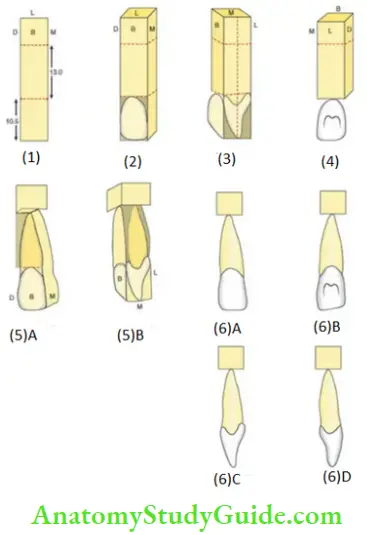Carving Of The Permanent Incisors
The steps in carving of the permanent maxillary central incisor will be described in detail. The permanent maxillary lateral incisor and permanent mandibular incisors can be carved following the same steps but with variation in features.
Table of Contents
Note: Measurements to be noted down from the respective chapters
Read And Learn More: Oral Physiology Notes
Carving Of The Permanent Maxillary Right Central Incisor
1. Mark the cervicoincisal dimension of the crown and the root on the wax block. The portion of the wax block beyond the root is called the base. Label the Surfaces at the bottom of the block as B, L, M, D indicating buccal, lingual, mesial and distal.
Note: B is used instead of L (for labial) to avoid confusion
2. Mark the mesio-distal dimension on the buccal surface of the crown at the cervical line and at the contact area. Draw the outline of the labial aspect on the crown. Carve the wax outside the outline (shaded portion) and thus create the mesial and distal surface of the crown. Make the disto-incisal line angle more rounded than the mesio-incisal line angle in order to differentiate between the permanent right and left central incisor.
3. Mark the midline of the block on the proximal aspect. Mark the labio-lingual dimension of the crown at the cervical line, at the crest of curvature and the incisal edge (2 mm). The incisal edge has to pass through the midline of the block. Carve the wax outside the outline and thus create the labial and the lingual surface of the crown with the lingual surface being narrower(lingual convergence) than the labial surface.
4. Carve the W shaped lingual fossa. The lingual fossa can be carefully carved with the discoid portion of the instrument.
5. Mark the shape of the root on the buccal and proximal side of the wax block and carve the wax outside the outline of the root (shaded portion). Make the root lingually converging.
6. Check for the dimension and complete carving the anatomy of the tooth in detail. Carve the cervical line and polish the tooth. The steps in carving the permanent maxillary lateral incisor and the mandibular incisors are the same.
The exceptions are mentioned below:
Carving Of The Permanent Maxillary Lateral Incisor
- Dimensions of the crown and the root.
- Outlines.
- Shape of the lingual fossa.
- Outline of the incisal edge
Carving Of The Permanent Mandibular Central Incisor
- Dimensions of the crown and the root.
- Outlines.
- The incisal edge is lingual to the midline.
- Shape of the lingual fossa.
Carving Of The Permanent Mandibular Lateral Incisor
- Dimensions of the crown and the root.
- Outlines.
- The incisal edge is lingual to the midline.
- The crown appears to be twisted on the root base.
- Shape of the lingual fossa.

Leave a Reply